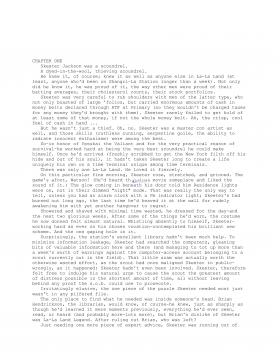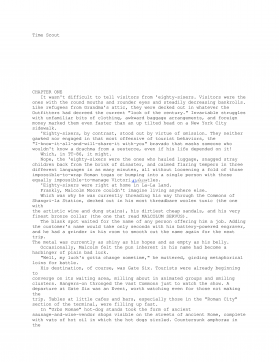Emerging Viruses-Aids & Ebola - By Leanard Horowitz
VIP免费
2024-12-03
2
0
556.7KB
127 页
5.9玖币
侵权投诉
EMERGINGVIRUSES:AIDS&
EBOLA
Nature,AccidentorIntentional?
Tetrahedron,Inc.1996.
LeonardG.Horowitz,D.M.D.,M.A.,M.P.H.
ForewardbyW.JohnMartin,M.D.,Ph.D.
"To do evil a human being must first of all believe that what he's
doing is good . . .
Ideology - that is what gives devildoing its long-sought
justification and gives the evildoer the necessary steatfastness
and determination. That is the social theory Which helps to make
his acts seem good instead of bad in his own and others' eyes, so
that he won't hear reproaches and curses but will receive praise
and honors."
-Russian dissident Alexander Solzhenitsyn
DEDICATED TO THE SEEKERS OF TRUTH
and to those who, regardless of risk, labor tirelessly to tell it.
TotheReader
THIS BOOK is painfully nonfiction - the story is true, the
characters, scientific and political, are real. Secondary references
have been checked and authenticated.
Since the importance of this information was clear, I labored to
write for both critical health scientists and intelligent lay readers
without losing either. Technical words are explained in lay terms
for all to better understand.
Though many people - black, white, gay, straight, Jew and
gentile - may wish to deny the implications of this work, the truth
is the truth. As British statesman Edmund Burke said in the wake
of the American revolution, "People never give up their liberties
but under some delusion." Perhaps now, as AIDS consumes the
lives, liberties, and pursuits of an estimated 30 million HIV-
positive people worldwide, the time has come to vanquish our
delusions about it and its origin.
Despite its social and scientific importance, the origin of HIV has
been clouded in mystery. Based on the mass of circumstantial
and scientific evidence presented herein, the theory that
"emerging viruses" like HIV and Ebola spontaneously evolved
and naturally jumped species from monkey to man must be
seriously questioned.
There is an old saying in medicine, that diagnosis is required
before treatment. The facts presented here, easily verified, may
help diagnose the man-made origin of the world's most feared
and deadly viruses. It is hoped this work will, therefore, help
redirect AIDS science in search of a cure, free AIDS victims
from the guilt and stigma attached to the disease, as well as
prevent such "emerging viruses" from reemerging.
I offer this investigation into the orgin of AIDS and Ebola for
critical review in the hope that it may also contribute to greater
honesty in science, to political, military, and intelligence
community reforms that are truly peace loving, and to self and
social reflection as a preventative against inhumanity.
-LEONARD G. HOROWITZ
Foreword
All at once, it seems, new viruses and virus-related diseases have
threatened the health of humans and many animal species. How
did this situation arise? Could it be that scientific studies and the
emergence of new pathogens are not totally unrelated events? In
writing this text, Dr. Horowitz has bravely questioned the extent
to which scientific research and lax government oversight may
have contributed to the present and coming plagues.
Open debate on this issue has been soundly discouraged.
Opponents to open dialogue on the apparent relationship between
early viral research and the latest germ discoveries argue that
little good, and considerable harm, would come from a full
disclosure of the facts. Exposing the truth, many believed, would
likely: I) tarnish the reputations of certain scientists, 2) make it
more difficult to maintain science funding, 3) promote
antigovernment sentiment, and 4) likely leave many issues
unresolved. Others argued that it was simply too late to undo past
mistakes. The fact that a better understanding of the new viruses'
origins could lead to new treatment approaches, and, more
importantly, to ways of preventing future outbreaks, was
disregarded.
In considering the recent genesis of HIV and the Ebola viruses,
Dr. Horowitz's book has explored three areas of great general and
scientific interest: 1) the history of intensive research into the
viral causes of cancer wherein readers can become familiar with
the many, now questionable, virus transmission experiments, 2)
the CIA and Department of Defense efforts to develop and
defend against biological weapons of germ warfare. Here Dr.
Horowitz should be especially congratulated for presenting well-
researched little known facts that, though highly disturbing, are
an important piece of history that may also bear heavily on the
emergence of new viruses, and 3) vaccine production. Clearly, as
anyone who reads this book will conclude, there is a great need
for more open dialogue concerning the past and present risks
inherent in the production of live viral vaccines. It is this topic
that I am pleased to address here.
In 1798, Edward Jenner, an English physician advanced the use
of cowpox (vaccinia) virus for immunizing humans against
smallpox. He recognized that pathogens can behave differently
while infecting different species. Indeed, he theorized that the
vaccinia infection, which caused mild problems for cows, caused
more severe ailments in horses. Only after adapting to cows, did
vaccinia acquire limited infectivity for humans. The open sores
that humans developed were far less severe than those induced by
smallpox (variola) virus and essentially remained localized to the
site of inoculation. Moreover, contact with vaccinia virus caused
individuals to become virtually immune to the widespread
disease caused by the small-pox virus. The success of vaccination
is reflected in today's total elimination of smallpox as a disease.
Jenner's vaccination approach was followed in the twentieth
century by Pasteur's use of rabies virus grown in rabbit's brain,
and by Theiler's finding that he could reduce the effect of yellow
fever virus by growing it in chicken embryos.
These successes set the precedent for other scientists to attempt
to reduce the pathogenicity of other human and animal viruses by
inoculating them into foreign species. Although we now look
back with some disdain at the crudeness of early immunization
experiments - such as the 1938 injections of polio virus, grown in
mouse brains, into humans, most people, including scientists, are
unaware that we still use primary monkey kidney cells to produce
live polio virus vaccine. Likewise, dog and duck kidney cells
were used to make licensed rubella vaccines. Experimental
vaccines, grown in animal tissues and intended for human use,
were commonly tested in African monkeys, and it is likely that
many of these monkeys were released back into the wild. This
practice may have led to the emergence of primate diseases, some
of which could have been transmitted back to humans.
Large numbers of rural Africans were also chosen as test
recipients of experimental human vaccines.
In veterinary medicine, live viral vaccines have been widely used
in domestic pets and in animals destined to become part of the
food-chain. Undoubtedly, many cross-species transfer of viruses
have occurred in the process. Even today, more than ten foreign
species are used to produce currently licensed vaccines for cats
and dogs.
The general acceptance of the safety of cross-species produced
vaccines was supported in part by the generalization that there
are inherent restrictions to the interspecies spread of disease.
Thus, like vaccinia, most viruses are less hanmful, but others can
be far more dangerous after invading a foreign host. One
dramatic example is that of the human infection caused by the
herpes-type monkey B virus. This germ remains a rather
harmless invader of monkeys, but place it in humans, and
striking, severe, acute illness results which commonly ends in
death. Likewise, a modified horse-measles-virus (morbillivirus)
can be lethal to man. Other examples include the relatively mild
dog distemper morbillivirus that was blamed for the death of
some 3,000 lions in the Serengeti; the cat-adapted parvovirus that
caused worldwide infection in dogs; and the mouse-derived
lymphocytic choriomeningitis virus that caused severe hepatitis
in monkeys.
It is the slow onset of disease that can be particularly baffling,
especially when considering potential viral diseases transmitted
through vaccines. Most acute diseases are relatively easy to
recognize and amenable to further prevention. The delayed onset
of chronic debilitating diseases that could be associated with
animal viruses finding their way into a new species, e.g., man,
are much more challenging. Here, the association between the
germ and the symptoms it causes is obscured. Such an
association would be especially hard to establish if the clinical
features presented during the illness are poorly defned and mimic
those of other known ailments. One example is the 1996 concern
over the food-borne transmission of the prion disease scrapie.
Initially carried by infected sheep, this protein caused bovine
spongiform encepalopathy in "mad" cows. Then it was
apparently passed on to humans resulting in juvenile Crutzfeldt-
Jakob disease.
While in some cases disease transmission has been traced to
certain vaccine lots, other times, even widely distributed licensed
vaccines have been found to be contaminated. Yellow fever
vaccine was known to contain avian leukosis virus.(* Editor's
note: This is the retrovirus that causes leukemia in chickens.)
During World War II, batches of yellow fever vaccines were
inadvertently also contaminated with hepatitis B virus. Current
measles, mumps, rubella (MMR) vaccines contain low levels of
reverse transcriptase, an enzyme associated with retroviruses.
Both Salk and Sabin polio vaccines made from rhesus monkeys
contained live monkey viruses called SV40, short for the fortieth
monkey virus discovered. As Dr. Horowitz documents, polio
vaccines may also have contained numerous other monkey
viruses, some of which may have provided some building blocks
for the emergence of HIV-l and human AIDS.
The finding of SV40 in rhesus monkey kidney cells, during the
early 1960s, led to a rapid switch to Mrican green monkeys for
polio vaccine production. Kidney cells from African green
monkeys, still being used to produce live polio vaccines today,
may have been infected with monkey viruses that were not easily
detectable. The monkeys used before 1980, for example, were
likely to have been infected with simian immunodeficiency virus
(SIV)-a virus genetically related to HIV-l. The origin of this virus
and whether it contaminated any experimental vaccines are issues
that need addressing.
What makes vaccines so troublesome is that their production and
administration allows viral contamination to breach the two
natural barriers that often restrict cross-species infections:
First is the skin. Direct inoculation of vaccines breaches this
摘要:
展开>>
收起<<
EMERGING VIRUSES: AIDS & EBOLA Nature, Accident or Intentional? Tetrahedron, Inc. 1996. Leonard G. Horowitz, D.M.D., M.A., M.P.H. Foreward by W. John Martin, M.D., Ph.D. "Todoevilahumanbeingmustfirstofallbelievethatwhathe'sdoingisgood...Ideology-thatiswhatgivesdevildoingitslong-soughtjustification...
声明:本站为文档C2C交易模式,即用户上传的文档直接被用户下载,本站只是中间服务平台,本站所有文档下载所得的收益归上传人(含作者)所有。玖贝云文库仅提供信息存储空间,仅对用户上传内容的表现方式做保护处理,对上载内容本身不做任何修改或编辑。若文档所含内容侵犯了您的版权或隐私,请立即通知玖贝云文库,我们立即给予删除!
相关推荐
-
公司营销部领导述职述廉报告VIP免费

 2024-12-03 4
2024-12-03 4 -
100套述职述廉述法述学框架提纲VIP免费

 2024-12-03 3
2024-12-03 3 -
20220106政府党组班子党史学习教育专题民主生活会“五个带头”对照检查材料VIP免费

 2024-12-03 3
2024-12-03 3 -
20220106县纪委监委领导班子党史学习教育专题民主生活会对照检查材料VIP免费

 2024-12-03 6
2024-12-03 6 -
A文秘笔杆子工作资料汇编手册(近70000字)VIP免费

 2024-12-03 3
2024-12-03 3 -
20220106县领导班子党史学习教育专题民主生活会对照检查材料VIP免费

 2024-12-03 4
2024-12-03 4 -
经济开发区党工委书记管委会主任述学述职述廉述法报告VIP免费

 2024-12-03 34
2024-12-03 34 -
20220106政府领导专题民主生活会五个方面对照检查材料VIP免费

 2024-12-03 11
2024-12-03 11 -
派出所教导员述职述廉报告6篇VIP免费

 2024-12-03 8
2024-12-03 8 -
民主生活会对县委班子及其成员批评意见清单VIP免费

 2024-12-03 50
2024-12-03 50
分类:外语学习
价格:5.9玖币
属性:127 页
大小:556.7KB
格式:PDF
时间:2024-12-03









 渝公网安备50010702506394
渝公网安备50010702506394
